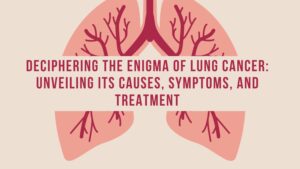- Attapur & Tolichowki ,Hayathnagar & Chikkadpally
- 6300063075, 9347407773, 7416664506, 7416664505
Welcome readers, as we delve into the intricate world of lung cancer – a disease that affects millions worldwide. In this article, we will explore various aspects of lung cancer, including its symptoms, causes, lung cancer treatment, and the efficacious therapy options available.
Lung Cancer Symptoms: A Glimpse into the Silent Intruder
Lung cancer is a stealthy intruder that often conceals its presence until it reaches advanced stages. Familiarizing oneself with the common symptoms can be a life-saving endeavor. Persistent coughing, shortness of breath, chest pain, unexplained weight loss, hoarseness, and coughing up blood are all potential signs of lung cancer. It is essential not to overlook these symptoms and seek medical assistance promptly to ascertain their origin.
Common Symptoms: Identifying the Early Warning Signs
Persistent Coughing – Impossible to Ignore:
A chronic and unexplained cough, often accompanied by blood-tinged phlegm, is a crucial symptom of lung cancer. Regular check-ups are vital to rule out any malignancies.
Shortness of Breath – A Labored Battle:
Individuals may experience breathlessness, especially during physical activities or exertion, due to lung cancer’s adverse effects on lung functioning.
Chest Pain – A Signal of Distress:
Chest pain, often radiating to the shoulder, back, or arms, should never be overlooked. Persistent pain hints at possible tumor growth and demands immediate medical attention.
Unintentional Weight Loss – A Silent Consequence:
Unexplained weight loss could signify a severe underlying condition like lung cancer. Dramatic weight loss without lifestyle changes is a matter of concern.
Cause of Lung Cancer: Peeling Back the Layers of the Causative Factors
Smoking, without a shadow of a doubt, takes center stage when discussing the primary cause of lung cancer. Tobacco smoke contains numerous carcinogens that can damage lung cells over time, leading to the development of cancerous growths. However, non-smokers can also develop lung cancer due to various factors such as exposure to radon gas, second-hand smoke, asbestos, and air pollution. It is crucial to be aware of these risk factors and take necessary precautions to minimize exposure.
Smoking – The Omniscient Instigator:
Smoking remains the primary cause of lung cancer, accounting for an alarming majority of cases. Cigarettes introduce harmful toxins, such as tar and nicotine, into the lungs, severely compromising their health.
Secondhand Smoking – A Stealthy Co-conspirator:
Non-smokers who are regularly exposed to secondhand smoke are also at a heightened risk of developing lung cancer. The inhalation of tobacco smoke not only endangers the smoker but also wreaks havoc on those in close proximity.
Radon Gas – A Deadly Intruder:
Radon, a naturally occurring radioactive gas, can seep into homes and buildings, posing a significant risk to lung health. Prolonged exposure to high levels of radon is strongly associated with an increased likelihood of developing lung cancer.
Occupational Exposures – Occupational Hurdles:
Certain occupations, such as mining, construction, and industrial jobs, entail greater exposure to harmful substances like asbestos, diesel exhaust, and silica dust. Such exposure increases the chances of contracting lung cancer.
Lung Cancer Treatment: Breaking the Shackles of this Lethal Disease
The lung cancer treatment landscape for lung cancer is constantly evolving, offering hope to patients and their loved ones. The selection of treatment depends on several factors, including the type and stage of cancer. Surgery, chemotherapy, radiation therapy, targeted therapy, and immunotherapy are all viable treatment options. Surgical intervention aims to remove the cancerous tumor, while chemotherapy, radiation therapy, and targeted therapy target cancer cells, impeding their growth. Immunotherapy, on the other hand, utilizes the body’s immune system to identify and destroy cancer cells. In advanced cases, palliative care plays a significant role in improving the quality of life for patients.
lung cancer treatment: A Beacon of Hope Illuminating the Path to Recovery
lung cancer treatment represents a ray of hope for patients, providing a multidimensional approach to combat this formidable enemy. Advances in medical science have led to the development of novel therapies that target specific mutations present in cancer cells, rendering them less resistant to conventional treatments. Modern therapies offer enhanced precision, reduced side effects, and increased survival rates.
Effective Treatments: Paving the Way Towards Recovery
Surgery – An Instrument of Hope:
Surgical removal of the tumor is one of the most common lung cancer treatment options if the tumor is localized. This potentially curative procedure aims to eradicate cancerous cells, giving patients a renewed chance at life.
Radiation Therapy – Targeting the Invaders:
Radiation therapy employs high-energy beams to eliminate cancerous cells. It can be used as a standalone treatment for early-stage cases or in combination with surgery and chemotherapy for advanced-stage lung cancer.
Chemotherapy – A Multifaceted Attack:
Chemotherapy utilizes powerful drugs to target and destroy cancer cells throughout the body. Regular sessions of chemotherapy, accompanied by diligent monitoring, play a crucial role in managing lung cancer.
Immunotherapy – Empowering the Body’s Defenses:
Immunotherapy harnesses the body’s immune system to combat cancer cells by enhancing its response. This innovative treatment option holds promise for both advanced-stage patients and those who fail to respond to other treatments.
Unraveling the Culprits:
The foremost question when it comes to lung cancer is determining its origin. Smoking remains the leading cause, as it introduces harmful chemicals that damage lung cancer treatment, paving the way for mutations capable of triggering cancerous cell growth. However, it is important to note that smoking is not the sole perpetrator. Factors such as exposure to secondhand smoke, environmental pollutants, radon gas, genetic predisposition, and even some occupational hazards also play a role in the development of lung cancer.
Decoding the Symptoms:
Recognizing the early signs and symptoms of lung cancer treatment is crucial for an early diagnosis and treatment. Persistent coughs that refuse to subside, chest pain, shortness of breath, sudden weight loss, and recurring respiratory infections are common indicators. However, it is essential to remember that lung cancer symptoms may not always be exclusive to this condition, making medical consultation imperative for accurate diagnosis and management.
The Treatment Journey:
Lung cancer treatment has come a long way, providing hope for patients and their families. The optimal approach varies based on the stage of the cancer, overall health, and personal preferences. Surgery, radiation therapy, chemotherapy, targeted therapies, and immunotherapy are some of the key treatment modalities tailored to the specific needs of each patient. Each method has its own merits and potential side effects, and a thorough discussion with healthcare professionals helps patients make informed lung cancer treatment decisions.
The Power of Therapy:
In recent years, lung cancer treatment has witnessed a remarkable revolution. Targeted therapies specifically identify and attack certain genetic or protein alterations within cancer cells while sparing healthy tissues, leading to improved outcomes and fewer side effects. Meanwhile, immunotherapy harnesses the body’s own immune system to fight cancer, offering promising results for patients who have exhausted other treatment options. Clinical trials also hold promise for breakthroughs in lung cancer treatment, offering the potential for enhanced treatments and an increased survival rate.
Conclusion:
Deciphering the enigma of lung cancer treatment a comprehensive understanding of its causes, symptoms, and treatment options. Recognizing the signs, avoiding the risk factors, and seeking timely medical intervention are pivotal in improving outcomes. With the advent of modern therapies, there is renewed optimism for patients battling this disease. Always stay vigilant, spread awareness, and unmask the mysteries surrounding lung cancer for a brighter and healthier future.
Quick Links
Quick Contacts
- +91 63000 63075 (Attapur)
- +91 93474 07773 ( Tolichowki)
- +91 74166 64506 ( Hayath Nagar)
- +91 74166 64505 ( Chikkadpally)
Our Branch's
- Oppo pillar No.151,Attapur
- Podium mall Tolichowki
- NH-65, Hayath Nagar
- Pillar No.1135,Chikkadpally
- Copyright 2023 ABS NEURO HOSPITAL
- Designed & developed by Shirisha Institute



Leave a Reply